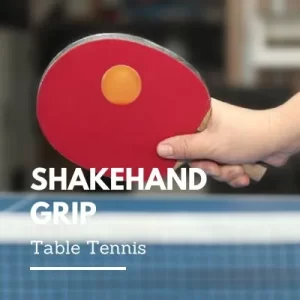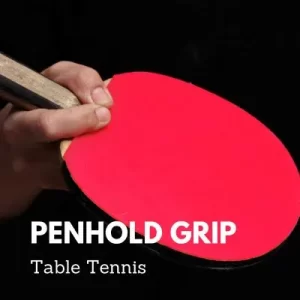One crucial aspect of the ping pong is the grip that a player adopts when holding the racket. The grip significantly influences the player’s technique, control, and shot execution. In table tennis, two primary grips are commonly used: the shakehand grip and the penhold grip. Each grip has its unique characteristics and advantages.
This article will explore the differences between these two grips and help you understand which one may suit your playing style and preferences.
Introduction
In table tennis, the grip refers to how a player holds the racket handle. It determines the player’s ability to generate power, control the ball, and execute various strokes with accuracy. The grip is a fundamental aspect of the game, and choosing the right one is essential for maximizing your potential as a player.
Table Tennis Grips
Shakehand Grip
The shakehand grip is the most popular and widely used grip in table tennis. It is called the shakehand grip because the player holds the racket handle as if they were shaking hands with someone.
In this grip, the index finger is extended over the racket head, and the other fingers wrap around the handle.
Penhold Grip
The penhold grip is less common than the shakehand grip but still widely used, especially in Asian countries. In this grip, the player holds the racket handle as if they were holding a pen, hence the name “penhold grip.”
The thumb and index finger hold the handle, while the other fingers are slightly spread out along the back of the blade.
Comparison between Shakehand and Penhold Grips
Playing style and technique
The shakehand grip offers a more versatile playing style, allowing players to utilize both forehand and backhand shots effectively. It is well-suited for players who prefer a well-rounded and adaptable game.
The penhold grip emphasizes quick and compact strokes, particularly on the forehand side. Players using the penhold grip often rely on their forehand shots and quick reflexes.
Flexibility and versatility
The shakehand grip provides greater flexibility in shot selection, enabling players to execute various strokes and adapt to different playing situations. It allows for a more significant range of wrist movement, making it easier to generate spin and power.
The penhold grip, while limited in terms of backhand shots, offers a higher level of versatility in terms of forehand play. Players using the penhold grip can generate tremendous power and spin with their forehand strokes.
Power and control
The shakehand grip provides excellent control over the racket due to the secure grip and larger contact area. It allows players to generate consistent shots with precise ball placement.
The penhold grip offers greater power potential on the forehand side due to the wrist action and leverage it provides. However, control may be slightly compromised compared to the shakehand grip.
Spin generation
Spin generation is vital in table tennis, as it allows players to manipulate the trajectory and bounce of the ball. The shakehand grip is generally more effective at generating spin, especially for backhand shots.
The penhold grip, while not as effective for backhand spin, offers exceptional spin potential on the forehand side. The wrist flexibility and quick brushing motion enable players to generate deceptive spins.
Difference Between Penhold grip and Shakehand grip
The main difference between the penhold grip and the shakehand grip lies in how the player holds the table tennis paddle.
Here are the key distinctions between the two grips:
Hand Positioning:
Penhold Grip: In the penhold grip, the player holds the paddle similar to how one would hold a pen or chopstick. The handle of the racket is held between the thumb and the index finger, with the other fingers typically wrapped around the backhand side of the paddle.
Shakehand Grip: With the shakehand grip, the player holds the handle of the racket as they would shake hands with someone. The handle rests in the palm of the hand, with the fingers wrapped around the handle from the backhand side.
Finger Placement:
Penhold Grip: In the penhold grip, the thumb and index finger are typically used to hold the racket handle, while the other fingers, such as the middle, ring, and pinky fingers, are curled around the backhand side of the paddle.
Shakehand Grip: In the shakehand grip, all fingers are used to wrap around the handle. The thumb is positioned on the backhand side of the paddle, opposite the index finger, which rests on the forehand side.
Grip Style:
Penhold Grip: The penhold grip allows for a more direct and intimate contact between the hand and the backhand side of the racket. It emphasizes wrist movements and provides better control for short and touch shots.
Shakehand Grip: The shakehand grip offers a more balanced distribution of control between the forehand and backhand sides of the racket. It facilitates a wider range of stroke variety, including more power on the forehand side.
Backhand Execution:
Penhold Grip: With the penhold grip, players typically use a combination of forearm and wrist movements to execute backhand shots. The grip may limit the range of motion and stroke variety on the backhand side.
Shakehand Grip: The shakehand grip allows for more flexibility and a wider range of backhand strokes. Players can utilize their entire arm’s range of motion, including the wrist, to generate power and spin on the backhand side.
Choosing the Right Grip
When choosing between the shakehand and penhold grips, it ultimately comes down to personal preference, playing style, and individual strengths. Some players may find the shakehand grip more comfortable and suitable for their style of play, while others may prefer the penhold grip.
It’s important to consider factors such as your physical attributes, natural strengths, and the type of shots you enjoy executing. Experimenting with both grips during training sessions can help you determine which one feels more natural and allows you to perform at your best.
Seeking guidance from a qualified table tennis coach can provide valuable insights and help you make an informed decision based on your skill level and goals as a player.
Advantages Of The Penhold Grip and shakehand grip
The penhold grip and shakehand grip are two common techniques used in table tennis (ping pong). Each grip has its advantages, and players may choose one based on their playing style, strengths, and preferences.
Here are some advantages of each grip:
Advantages of the Penhold Grip:
Better control: The penhold grip allows for greater control over the racket due to the direct contact between the fingers and the backhand side of the paddle. This grip is particularly advantageous for short and touch shots.
Quick transition between forehand and backhand: With the penhold grip, players can easily switch between forehand and backhand shots without having to adjust their grip. This can provide an advantage during fast-paced rallies and quick exchanges.
Improved wrist flexibility: The penhold grip allows for greater wrist flexibility, enabling players to generate different spins and angles with their shots. This can be advantageous in creating unpredictable shots and varying the game’s pace.
Advantages of the Shakehand Grip:
More power on the forehand: The shakehand grip enables players to generate more power on their forehand shots by utilizing the full range of motion of the arm and wrist. This grip is beneficial for aggressive and offensive playing styles.
Better backhand reach: The shakehand grip allows players to have better reach on their backhand side. With the thumb resting against the backhand side of the racket, players can achieve a more extended reach and hit shots from wider angles.
Versatility: The shakehand grip provides greater versatility in terms of shot selection. It allows players to utilize various techniques, including topspin, backspin, and sidespin, with relative ease. This versatility can be advantageous in adapting to different opponents and game situations.
Ultimately, the choice of grip depends on the player’s comfort, skill level, and personal playing style.
DisAdvantages Of The Penhold Grip and shakehand grip
While the penhold grip and shakehand grip have their advantages, they also have some disadvantages that players should consider.
Here are some potential drawbacks of each grip:
Disadvantages of the Penhold Grip:
Limited backhand stroke variety: The penhold grip can restrict the range of motion and stroke variety on the backhand side. Players using this grip may find it challenging to generate as much power and spin on their backhand shots compared to the forehand.
Difficulty with certain shots: Certain shots, such as the traditional backhand loop, can be more challenging to execute with the penhold grip due to the grip’s inherent limitations. Players may need to rely more on their forehand or develop alternative techniques to compensate.
Vulnerability to certain serves: The penhold grip may make it more difficult for players to handle certain types of serves, particularly those with heavy backspin. The grip’s positioning can limit the wrist’s ability to generate enough power to lift the ball effectively.
Disadvantages of the Shakehand Grip:
Less control on the backhand: Compared to the penhold grip, the shakehand grip typically offers less control on the backhand side. The increased distance between the fingers and the backhand side of the paddle can result in reduced touch and precision on certain shots.
Slower transition between forehand and backhand: Unlike the penhold grip, the shakehand grip requires players to adjust their grip or reposition the racket when switching between forehand and backhand shots. This adjustment can lead to a slight delay, potentially impacting the speed of play in fast-paced rallies.
Limited wrist flexibility: The shakehand grip restricts the wrist’s range of motion compared to the penhold grip. This limitation can make it more challenging to generate certain types of spins and angles, especially on the backhand side.
Some players have found ways to overcome these limitations through training and adjustments to their playing style.
it’s up to each player to assess their strengths, weaknesses, and preferences when choosing a grip.
Conclusion
The choice between the shakehand grip and the penhold grip in table tennis depends on various factors, including playing style, technique, and personal preference. Both grips have their advantages and limitations, and players should choose the grip that suits their style of play and maximizes their strengths.
To understanding the differences between these two grips, you can make an informed decision and develop your game accordingly. Whether you choose the shakehand grip for its versatility or the penhold grip for its power and spin potential, consistent practice and proper training are key to mastering your chosen grip and becoming a skilled table tennis player.
FAQs
Which grip is better for beginners?
Both grips can be suitable for beginners. However, the shakehand grip is generally considered more beginner-friendly due to its versatility and ease of learning.
Can I switch between grips?
While it is possible to switch between grips, it can be challenging and may require significant adjustment and practice. It is advisable to choose one grip and focus on developing your skills with that grip.
Do professional players use both grips?
Professional players generally specialize in one grip that suits their playing style. However, there are a few exceptions where players have successfully used both grips, but it is relatively rare.
Is one grip more popular than the other?
The shakehand grip is more popular worldwide, particularly in Europe and North America. The penhold grip, on the other hand, is more prevalent in Asian countries.
Are there other types of grips in table tennis?
Yes, there are variations and adaptations of the shakehand and penhold grips. Some players use modified versions or hybrid grips that combine elements from both grips to suit their preferences and playing style.



